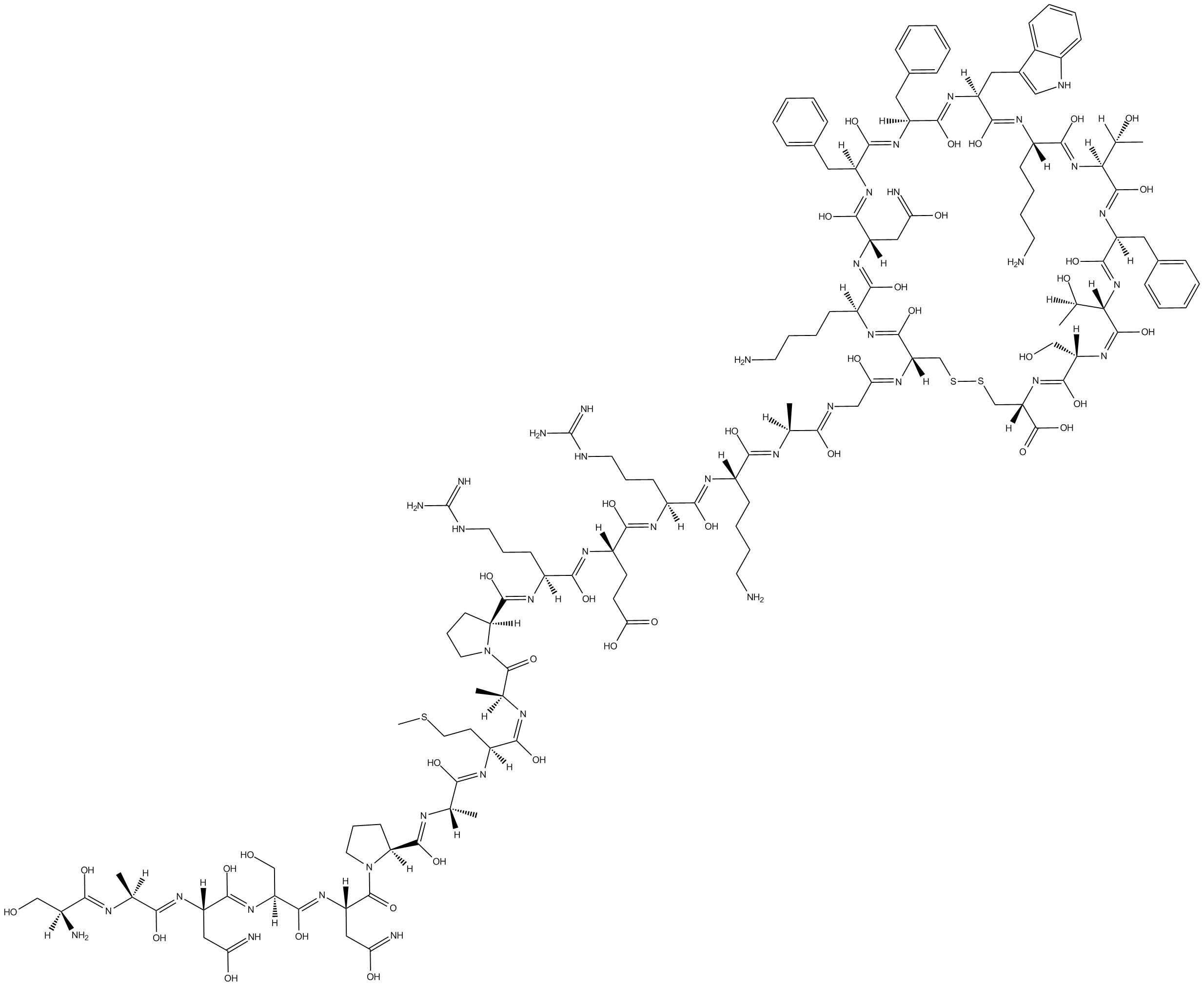Octreotide acetate
Octreotide acetate (Sandostatin) is an octapeptide congener of native somatostatin, inhibits the secretion of insulin and glucagon. It reduces production of IGF-1 and IGF-2 by the liver by modulation of growth-hormone secretion from the pituitary gland. [1]
The insulin-like growth factors IGF-1 and IGF-2, endogenously produced polypeptide hormones and potent stimulators of cell proliferation, are under investigation as clinical targets in prostate cancer.
Octreotide acetate decreased the urinary excretion of uric acid as well as the plasma concentrations of glucagon and insulin. Octreotide acetate decreased the urinary excretion of sodium and chloride without significiant influence on creatinine clearance, while the concentrations of lactic acid, pyruvic acid in blood, and cyclic AMP in plasma were not changed. [1]
References:
[1] Tetsuya yamamoto, Yuji moriwaki et al. Effect of Octreotide acetate on the Plasma Concentration and Urinary Excretion of Uridine and Purine Bases. Endocrine Journal 2002, 49(2),139-144.
| Physical Appearance | A solid |
| Storage | Store at -20°C |
| M.Wt | 1079.29 |
| Cas No. | 79517-01-4 |
| Formula | C51H70N10O12S2 |
| Synonyms | SMS 201995; Sandostatin |
| Solubility | ≥53.96 mg/mL in DMSO; ≥10.04 mg/mL in EtOH; ≥28.85 mg/mL in H2O |
| Chemical Name | (4S,7S,10S,13R,16S,19R)-13-((1H-indol-3-yl)methyl)-19-((R)-2-amino-3-phenylpropanamido)-10-(4-aminobutyl)-16-benzyl-N-((2R,3R)-1,3-dihydroxybutan-2-yl)-7-((R)-1-hydroxyethyl)-6,9,12,15,18-pentaoxo-1,2-dithia-5,8,11,14,17-pentaazacycloicosane-4-carboxamide |
| SDF | Download SDF |
| Canonical SMILES | O=C(N[C@H](CC1=CNC2=CC=CC=C12)C3=O)[C@@H](NC([C@@H](NC([C@H](N)CC4=CC=CC=C4)=O)CSSC[C@H](C(N[C@@H]([C@H](O)C)CO)=O)NC([C@](NC([C@H](CCCCN)N3)=O)([H])[C@H](O)C)=O)=O)CC5=CC=CC=C5.CC(O)=O |
| Shipping Condition | Small Molecules with Blue Ice, Modified Nucleotides with Dry Ice. |
| General tips | We do not recommend long-term storage for the solution, please use it up soon. |
| Cell experiment: [1] | |
|
Cell lines |
Human HUV-EC-C endothelial cells |
|
Preparation method |
The solubility of this compound in DMSO is >10 mM. General tips for obtaining a higher concentration: Please warm the tube at 37 °C for 10 minutes and/or shake it in the ultrasonic bath for a while.Stock solution can be stored below -20°C for several months. |
|
Reaction Conditions |
1 μM, 72 hours |
|
Applications |
Octreotide 1 nM produced a maximum 45.8% reduction of cell proliferation as compared to control cultures, from 9.7 to 4.4 x l03 cells/well. To assess the influence of medium supplements on the inhibition of HUV-EC-C cell growth. Octreotide was tested against graded concentrations of ECGF and heparin in the culture medium. Overall, these changes did not significantly affect the growth-inhibitory activity of octreotide as compared to baseline conditions. |
| Animal experiment: [2] | |
|
Animal models |
Male Sprague-Dawley rats |
|
Dosage form |
Subcutaneous injection, 1 µg/kg, 10 µg/kg and 200 µg/kg |
|
Applications |
NREMS and SWA were normal after 1 µg/kg octreotide. REMS, however, enhanced significantly during the light period. The increases in REMS started 2–3 h postinjection and persisted during the rest of the day, although they were very small when the individual hours were considered. In response to 10 µg/kg octreotide, NREMS was significantly suppressed in hour 1 postinjection. Calculated for the 12-h light period, NREMS or SWA did not differ between the baseline and the octreotide days. |
|
Other notes |
Please test the solubility of all compounds indoor, and the actual solubility may slightly differ with the theoretical value. This is caused by an experimental system error and it is normal. |
|
References: [1] Danesi R, Agen C, Benelli U, et al. Inhibition of experimental angiogenesis by the somatostatin analogue octreotide acetate (SMS 201-995). Clinical Cancer Research, 1997, 3(2): 265-272. [2] Beranek L, Obal Jr F, Taishi P, et al. Changes in rat sleep after single and repeated injections of the long-acting somatostatin analog octreotide. American Journal of Physiology-Regulatory, Integrative and Comparative Physiology, 1997, 273(4): R1484-R1491. |
|
Quality Control & MSDS
- View current batch:
Chemical structure











